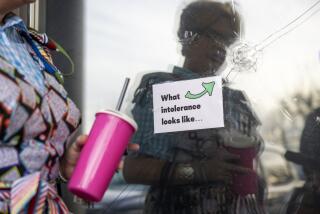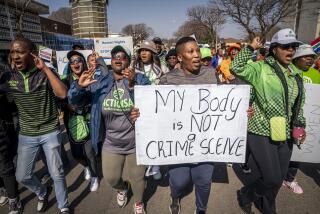Troops Find Anchor, but No Hussein
Just before dawn, U.S. troops descended from the skies in massive force upon this remote village of mud huts and shepherds. Their quarry: Saddam Hussein, a top henchman and squads of loyalist fighters said to be holed up here.
But instead of the former dictator, the soldiers ran into bewildered inhabitants, agitated dogs and CBS newsman Dan Rather, decked out in a flak jacket and a blue helmet.
“This is the cleanest place we’ve been to,” a frustrated Maj. Robert Gwinner said after determining that there were no known enemies or arms caches.
So it goes these days in the often-exasperating hunt for Hussein: lots of expectation, lots of energy and hours expended and lots of what the soldiers call “dry holes” -- leads that go nowhere.
One theory shared by troops here is that planning -- including close passes by U.S. scouts -- tips off the enemy.
“Keep in mind that the other side has its scouts too,” noted one GI, a veteran of half a dozen missions seeking so-called high value targets -- Army-speak for Hussein or other most-wanted regime loyalists. “And they know the country a lot better than we do.”
U.S. raids targeting Hussein, close associates or suspected fighters are daily events in Iraq, especially in the territory north and west of Baghdad patrolled by the 4th Infantry Division, which is based in Tikrit, near Hussein’s hometown. Journalists are keen to “embed” with “4 ID,” hoping they will be along for the operation that snares the ousted leader.
By most accounts, Hussein is believed to be moving among relatives and friends somewhere in the arid expanses, evading detection by relying on tribal connections. Intelligence suggests that he may have grown a beard or even be wearing a bomb to avoid being taken alive. Whether any of this is true remains to be seen.
“You probably won’t find him with a beret,” one commander advised his troops before the incursion early Tuesday into this hardscrabble hamlet, about 30 miles east of Tikrit.
Informant reports suggested that Hussein may have been spotted recently in the vicinity, which was described as his mother’s ancestral homeland. Also said to have been seen in the area was Izzat Ibrahim, a military aide to Hussein who was No. 6 on the U.S. most-wanted list and is now the top fugitive after Hussein.
Officials say the $25-million reward on Hussein’s head has prompted hundreds of tips, many of them dubious.
Extensive planning and rehearsal went into the raid last week, which was undertaken by nearly an entire battalion from the 3rd Brigade Combat Team, part of the 4th Infantry Division. Reports of the presence of Fedayeen Saddam militiamen resulted in a deployment of about 400 soldiers, some armed with missile launchers. Artillery, Apache attack helicopters and Air Force support were on standby. Planners working from satellite photographs assigned numbers to each of the town’s structures.
Teams were assigned to secure specific objectives and given code names such as Vulture1. Particular attention was given to House No. 38, where groups of young men in white pickups had been seen congregating around an older man.
Another target was a certain “Sheik Mubarak,” said to be close to Hussein and known to own a herd of 1,000 sheep. (Later, the sheik’s son said his father met Hussein only once, at a formal event attended by many tribal leaders.)
“I want everything to be squeaky clean,” the battalion commander, Lt. Col. Nate Sassaman, told his troops before they boarded the choppers. “We got media all over the place.”
Big Chinook helicopters brought the first 100 or so troops just before dawn, disgorging them just outside the mud walls. Dogs yelped, chickens squawked and terrified villagers stared at the twilight figures as if they were alien invaders just beamed in from the heavens.
Soldiers sealed the village’s entrances and exits. Dozens of armored vehicles soon were rumbling in. Wire and metal posts for a temporary holding pen were unloaded from a flatbed truck.
“Why would a man such as Saddam ever come to this place?” asked a perplexed Aziz Shuker Himid, 46. He was standing alongside his five incredulous children, huddled in beds placed outdoors, as is the custom here, to take advantage of nighttime cooling. “We’ve only seen Saddam on television.”
Dan Rather and his crew also had arrived by helicopter. No real action was to be found, but the celebrity newsman posed for photos with delighted fighters and headed out with the brigade colonel in search of the sheik of 1,000 sheep.
Soldiers searching homes uncovered nothing more incriminating than a single rocket-propelled-grenade round, a paltry thing in Iraq. Another dry hole.
After a few hours, the battalion packed up its portable holding pen and headed south, looking to “clear” several other villages. Not a shot had been fired.
“You never know unless you try,” Lt. Col. Sassaman said. “We had to come see for ourselves.”
More to Read
Start your day right
Sign up for Essential California for news, features and recommendations from the L.A. Times and beyond in your inbox six days a week.
You may occasionally receive promotional content from the Los Angeles Times.






